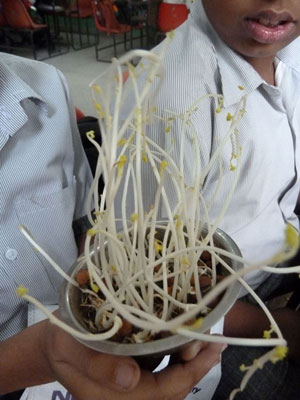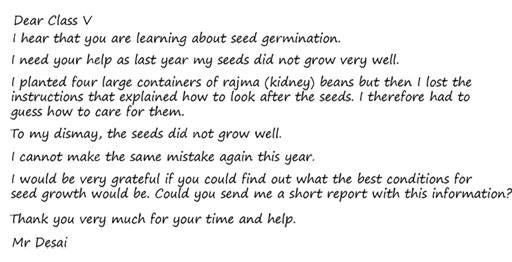3 Developing classroom routines to help students feel secure
Effective teachers try to create and implement classroom management practices that cultivate an engaging classroom environment for their students. Two specific areas of cognitive spaces that need to be included in their plans are: setting clear expectations such as rules and procedures for behaviour, and ways of participating. Such rules could be devised together with your students rather than you imposing the rules on them. It is a way of building up a collective responsibility for each other and respecting each person as an individual.
Pause for thought How can you develop clear expectations with your students of how to interact and listen to each other using the investigation into germination or another investigation you will be doing soon? |
Case Study 2: Mrs Yadav investigates germination – a rich task
Mrs Yadav, an elementary science teacher, wanted to inspire her students to devise their own investigation into germination. She needed to give them a task that had relevance to their everyday lives in a rural community. To do this, she decided to read out a letter to her students, pretending that it had been written by a local farmer called Mr Desai (Figure 2).
As soon as I had read out the letter to them, my students were most concerned about his situation and very keen to help him.
First, I asked them to think what the essential requirements for successful germination were, which I wrote on the blackboard. I then asked my students, ‘How can we be sure that this information is right? What will happen if we send the wrong information to Mr Desai and his seeds don’t grow properly?’
One of my students suggested that we could buy some seeds and try to grow them under different conditions to ensure that Mr Desai received the correct information. The next day, I brought some seeds into school.
I arranged my students into groups of six and asked them to think about what they wanted to find out and how this would help Mr Desai. I asked them to write down any questions they had about seeds and to think how we could record the results over time as the seeds grew. I told them of my desire to improve the classroom environment and that we needed to share our results from the investigation. How could we share them in a way that would enable us to do so regularly and improve the classroom?
I walked around the class listening to their talk. When I stopped the class and asked them to share their questions I was pleasantly surprised by what they said. One group asked the question, ‘Can seeds die if you give them too much water?’ We discussed how we could investigate these ideas and each group agreed to set up a control seed that had all the necessary conditions for growth. Then each group also sowed a seed that had no light, water, soil, attention or warmth. One group set up a pot with a seed that would have lots of water. Another group set up a seed with all conditions except warmth, putting it in a freezer.
I gave my students a simple chart to record their observations and asked them to look after their seeds and record their observations at least every two days over a period of two weeks [Figure 3]. Some students drew pictures to record their observations; others added labels and captions. All checked for growth and measured it with a ruler.

To share their results as they developed, we put all the charts on the wall above each pot. The names of each group were also displayed. This was so that they could ask each other about their plants. I made a poster titled ‘Germination’, wrote out what they had done and displayed this beside the charts. I was surprised by how much they looked at the seeds and talked to each other about what they thought was happening. There was great excitement when the first shoots were seen peeping through the soil. Everyone checked which seed it was.
After three weeks, I asked each group to write a letter back to Mr Desai, explaining what they had done with their seed, what evidence they had collected and what this evidence told them about seed growth. These letters were displayed beside their charts and above their seeds.
I left the charts up on the wall. Later, when we had done some other work on plants, we put it beside the germination display. My plan now is to try to have some display for every big topic we do – not always the students’ work, but sometimes using charts that we have in school.
The students often commented on how they liked stuff on the walls that was interesting to look at. It certainly had stimulated their interest and talk.
Pause for thought
|
Activity 4: Investigating germination
Using your responses to Activity 2, refine your plan for your students to do the investigation. How will you introduce this to your students? Will you use a letter like Mrs Yadav? How will you encourage and question your students to think about whether their plan will answer the question ‘What are the best conditions for germination?’ Identify where you will keep the plants and where you can display the recording sheets (see Resource 4 for a sample recording sheet). Think how you can develop this display to communicate their findings to a wider audience in the class and school.
Now teach the germination lessons to your students.
Pause for thought
|
2 Developing a cognitive space

